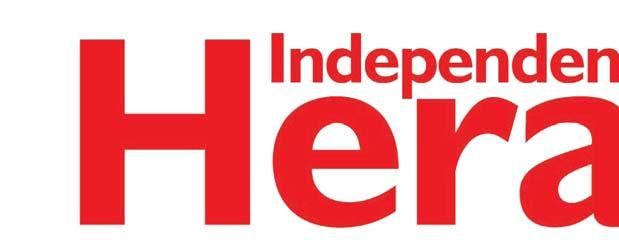




By Frank Neill
The Newlands community has launched a two-year pilot to implement a locally designed “Coordinated Community and Disaster Resilience” model.
Designed to demonstrate the value of enhanced community connectedness as an essential foundation for resilience, it is also intended to provide a call to action to local and central government to support community-led initiatives such as this.
Continued on page 2.
At the Newlands Community Gardens (from left) Rodney Barber (NRG Leader), Fionna Sheppard (Community Gardens) , Hamuera Orupe McLeod (NRG Tikanga Maori lead), Tim Turnidge (Community Gardens) and Sanaa Rafique (NRG Catalyst Lead). Photo: Howie.






















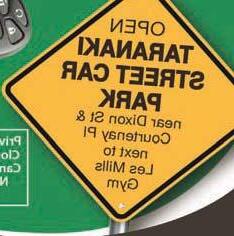








Phone (04) 587 1660
www.independentherald.co.nz




REPORTER
Frank Neill
herald@wsn.co.nz 027 490 3916
NATIONAL
SALES
Les Whiteside
les@wsn.co.nz 021 360 008
SALES
Steve Maggs steve@wsn.co.nz 027 765 8303
SALES
Brenda Ingram-Johnson brenda@wsn.co.nz 021 640 152

CLASSIFIED SALES
classifieds@wsn.co.nz

Continued from page 1.
The first stage of the pilot seeks to recruit 100 volunteers to each lead a neighbourhood group focused on building connections and cohesion.
Ultimately, they will begin to implement the disaster resilience model developed, with a view to ensuring the community can look after itself for the first seven days after a disaster, before government support is in place.
The model will be fully activated based on insights from previous disasters.
Led by the Newlands Resilience Group, the pilot puts into action the strategy they developed, which was informed by the results of annual community surveys since 2019 to map the community’s vulnerabilities and capabilities.
Newlands Resilience Group Leader, Rodney Barber, says the survey insights clearly demonstrated that the first step in improved disaster resilience would be to improve community connectedness.
“We engaged with a wide range of local social, economic and cultural leaders, including Ng Hau e Wh o Papar rangi, schools, health centres and places of worship, and found that there are real economic, environmental, social
and cultural vulnerabilities that need to be addressed.
“It stands to reason that improved connectedness enables more robust disaster resilience, and it is also critical for empowering the community to be able to speak up to influence decisionmaking, which is the key to driving overall public value long term,” Mr Barber says.
For example, the Newlands project to improve connectedness as the first step in improved disaster resilience not only offsets what local and central government might have to invest in themselves to support disaster resilience but also generates wider benefits such as reduced pressure on publicly funded mental health services.
“Our modelling indicates forecast savings from reduced demand on publicly funded services of up to $4 million per year for Newlands alone,” Mr Barber says.
“We’re also documenting refinements to our model to create a scalable model for other communities, requiring less upfront investment from them to take a similar approach, and further magnifying the overall public benefit.”
The first stage of the pilot phase of the Newlands project is being implemented by the commu-


nity itself (through 2026), but it is hoped that it will attract central and local government investment as the public value benefits are
demonstrated (to provide funding for 2027, with the expectation of becoming self-funding in the future).
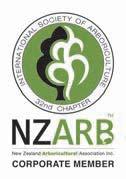



I recently hosted a meeting which included local property developers and representatives from the City and Regional Councils. The background for the meeting was the need to ensure all people involved in providing more housing in our electorate, whether it be those building them or those regulating and permitting that building, understand the issues which govern the ability to build the houses everyone agrees we need.
As Wellingtonians, we need to be our own best advocates.
The Government and the rest of New Zealand are happy to see our public service run into the ground, and our public servants sacked from their jobs, until of course the shortages quickly and inevitably start to affect them in their business and personal lives. After all, the ‘they’ people believe should do things to improve the efficiency of the country are the very people and bureaucracy they think they want gone.
There are essentially two types of development; greenfields and brownfields. Greenfields means building on currently undeveloped land, typically ex farmland on the edges of current urban areas, where infrastructure like sewers, water supply and other essential services don’t exist are usually built by the developer.
Brownfields development means rebuilding on existing sites, and there has been considerable discussion in recent times around how much intensification should be allowed in existing suburbs, especially changing of height limits to allow for more apartments.
Both have their advantages and disadvantages; the Regional Council in particular see their role to prevent more
It’s sad that many Wellingtonians seem to join this chorus instead of appreciating just what a great city we have. And there’s plenty to appreciate. Over the weekend I officiated at the opening of a bush track carved out of the slopes of Mt Kaukau by a group of dedicated volunteers, the track joining Ngaio with
runoff and other material ending up in our harbours, especially the Porirua harbour in the case of development north of Johnsonville and Newlands. The Wellington City Council are concerned that the existing infrastructure cannot handle the pressure it comes under when new housing areas are developed. Existing infrastructure is aging and needs upgrading across our city, as evidenced by recent pipe failures. An advantage of intensification of existing areas means more people, therefore more ratepayers to pay for those upgrades.
Khandallah. It completes a network of similar tracks and progress which allows people of all sorts of mobility to get into our magnificent hills and enjoy the harbour views at the same time.
The completion of the seawall and walking/cycling trail from Petone to the city will facilitate similar access to the western harbour.
Developers of course need to make a profit, and wish to keep their compliance costs as low as possible. Many believe the Resource Management Act is too cumbersome. We as government for our part have undertaken to rewrite that act.
The feedback was good, but the success will be when there are sufficient affordable houses to meetdemand. That is certainly my goal as your MP.
That, and of course having a vibrant and functioning Johnsonville Shopping Centre we can all be proud of.
There’s plenty to be getting on with.
So, despite the current Government’s attacks on our city, we can begin the fight back by being Wellington’s best advocates, and we do that by discovering and enjoying what we have. And that doesn’t even take into account the still-vibrant city shopping and entertainment scene. There are more car parks and it’s safer than the naysayers would have us believe, and there’s always the bus and train.

By Frank Neill
Wellington City Council spending and big rates increases were the two major items Mayoral candidates spoke about at a candidates meeting in the Khandallah Town Hall on 26 August.
Hosted by the Onslow Residents Community Association, the meeting was addressed by eight of the 12 Candidates standing for the Mayoralty at the upcoming local body elections.
The eight were Diane Calvert, Ray Chung, Rob Goulden, Kelvin Hastie, Andrew Little, William Pennywise, Joan Shi and Karl Tiffenbacher.
“What we [the Council] have got to do is cut our expenditure,” Cr Diane Calvert said.
“We need to reset our priorities and we need to reset our budget.
“We need to look after what we have already got. We don’t need to keep reinventing things.”
“Rates are killing us,” Karl Tiffenbacher said.
“I love Wellington but it has just become unaffordable.
“It’s become unaffordable to be living here.
“It’s become unaffordable to actually do business in Wellington.
“I think that is where we have lost track with the Council.
“At the moment we have lots of projects we are doing which we simply cannot afford. That’s unsustainable.
“If you were a company you would be bankrupt.”
The Council, Karl said needs “to look at every single thing we are spending money on.
“The Golden Mile – it needs to stop immediately; the organic waste – it needs to stop immediately; the cycleways – they need to stop immediately,” he said.
“We need Wellington back to the vibrant city it was only 15 years ago. I don’t think it’s that hard.”
“We [the Council] haven’t been able to stop the spending,” Cr Ray Chung said.
“We can’t stop the projects ... that result in the spending.
“I want to run the Council like a business.
“We need the business sense. We need to









account for what we actually do,” Cr Chung said.
Compared with what was happening currently “there are much much better ways of doing things,” he added.
“The Council seems to be incapable of getting spending under control,” Andrew




Little said.
“I find the rates increases in Wellington unbelievable and unacceptable.
“The Council cannot keep spending at the rate it is doing at the moment.
“The Council has got to keep its spending under control,” he said.
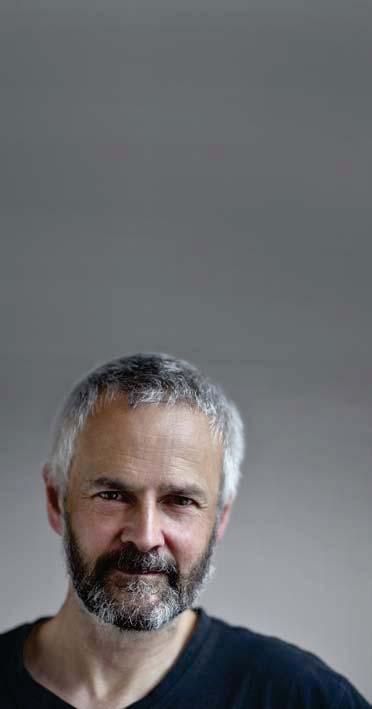































Night works are planned for the State Highway 1 on-ramp at Johnsonville.
The State Highway 1 Johnsonville northbound on-ramp will be closed for road repairs and resurfacing patches between 9pm and 4am on Sunday 31 August.
Drivers should detour via Moorefield Road, Middleton Road, Westchester Drive and then access SH1 via the Glenside/ Churton Park on-ramp. “This is critical state highway maintenance and essential for keeping these well-used state highway ramps safe and reliable for drivers,” NZTA Waka Kotahi says.
By Frank Neill
Te W o te K anga - Spring Festival 2025 will come to Wellington’s gardens from 1 to 30 September.
The festival is, the organiser say, “the perfect way to get amongst the k anga flowers and celebrate the season of new beginnings where fresh buds bloom and life starts anew.”
All the events during the festival are free. Botanical Art Worldwide 2025 will be held in the Treehouse, Botanic Garden ki Paek k , from 9am to 4pmweekdays and 10am to 4pm weekends from 1 to 30 September. The Art of Okebana Exhibition will be held at the Begonia House, Botanic Garden ki Paek k , from 9am to 4pm on 6 and 7 September. The spring floral display accessible self-drive tour will be held at Botanic Garden ki Paek k , from 10am to 3pm from 8 to 12 and 15 to 19 September.
R TŪwhera ki tari | tari Open Day will take place at tari-Wilton’s Bush from 10am to 12:30pm on 13 September.
Te hua o te Haenga | Pollination in Motion will be held at the Treehouse and Discovery Garden, Botanic Garden ki Paek k , from 10am to 2pm on 20 September.
Kaiwhakaataata M ra | Garden Performerswill take place at tari-Wilton’s Bush and Botanic Garden ki Paek k from 10am to 2pm on 27 September. Friends garden walks will be held at Botanic Garden ki Paek k from 1:30pm to 2:30pm on 6, 13 and 20 September. Government House garden tours will take place at Government House gardens at 10:30am on 12, 26 and 30 September.

By Aman Khalid*
At just 18, Karori resident Tom Xu is already making his mark in governance.
He is head of the student council at Wellington College and the student representative on the college’s Board.
He was also selected as Youth MP for MP Simon Court at the 2025 triennial Youth Parliament, a youth development programme run by the Ministry of Youth Development, which entailed a two-day event at the Beehive building.
Each MP selected a young person to represent their electorate, while a panel appointed 20 young writers to step into the shoes of the Press Gallery members.
Tom says he decided to become a Youth MP because he thinks “it is a great opportunity to represent my community and voice out their concerns at a national level”.
A key feature of the Youth Parliament

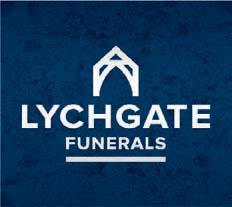

event was the general debate, in which 80 Youth MPs had the opportunity to speak out on issues they are passionate about, in the debating chamber itself.
Tom’s speech was about the disparities in educational outcomes.
Across Aotearoa unequal access to education remains a challenge even in New Zealand’s so-called world-class education system.
As the final speaker in the debating chamber, Tom emphasised the urgent need to address inequities in education.
“While we acknowledge and appreciate what is being done to improve educational outcomes, we simply think it isn’t enough,” Tom said.
“The purpose of an education is to open up the most amount of viable pathways for everyone, but the schools in our country with lower equity index rankings have drastically worse academic performance compared to those with a higher one”.


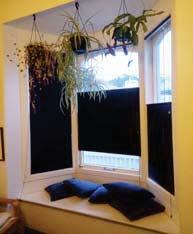
Tom believes that currently, government policies tend to prioritise schools with higher equity rankings, and instead “straight-up ignore the lower equity index schools”. This issue doesn’t get nearly enough attention, which contributed to his motivation behind calling it out at Youth Parliament. Looking forward Tom hopes that “the government and the general public have their eyes on lower equity index schools” and calls for more attention to schools with lower equity rankings.
Amid the recent proposal to scrap NCEA altogether, conversations surrounding the future of the education system are increasing. Now more than ever, it is important to ensure the future of Aotearoa’s education system not only supports those already advantaged but uplifts students from all backgrounds Tom says.
*Aman Khalid is a Year 13 Student at Westlake Girls’ High School and was a member of the Youth Press Gallery 2025.




A new initiative will see Wellington local election candidates answering some of the big questions in online videos to help voters make a more informed decisionthis year.
Of the 50 Mayor and Councillor candidates, 47 took up Wellington City Council’s offer of a short video answering the same questions about their skills and strengths, decision-making for their community, and what the key challenges and opportunities are for the city.
The videos appear with the candidate statements online at wellington.govt.nz/ candidates.
Candidate booklets featuring their statements will also be included with voting papers being delivered between 9 and 22 September to enrolled voters.
The videos are just one of several initiatives available to make voting more accessible for everyone, the Council’s Deputy Electoral Officer Jennifer Parker says.
“As well as the online candidate statements and videos, there will also be candidate booklets in accessible formats online and at the 2025 Election Hub at the Brandon Street Te Awe Library throughout the voting period from early September.
“The Electoral Commission website vote. nz also has information about enrolling and voting in alternate formats including braille, audio, large print and in different languages.
“A lack of information about candidates is a key reason why people do not vote, so we encourage voters to also find out more about the candidates, and see them in person at the many community-run Meet the Candidate events which are in full flight all around P neke, and check out policy.nz in September to compare candidates running in your area.”
The local elections are conducted by postal vote, and people who are enrolled can expect to receive their voting packs in the mail from 9-22 September. Voting closes at 12 noon on Saturday 11 October.
The last day to enrol to receive voting papers by mail was 1 August, but people can enrol up until 10 October 2025. Those people will need to cast a special vote.
More information is available for voters and candidates at wellington.govt.nz/elections, including key dates, FAQs, ward maps and details about the M ori ward poll.
Preliminary and final election results will be available at wellington.govt.nz/elections once the votes are processed.
The Living Wage Movement Aotearoa has congratulated Greater Wellington Regional Councillors, staff and, most importantly, the community that has come together to see the regional council become a Living Wage Employer.
“It is almost two years to the day since GWRC Councillors passed a motion to pursue Living Wage Accreditation, Rev Stephen King said in his address to the council.
Rev King, who is Archdeacon of Wellington, chairs Living Wage Movement Aotearoa NZ.
“We set up a working group with the Council and have worked closely with them to ensure a smooth path toward GWRC stepping up and becoming a Living Wage Employer,” he said.
“This move ensures a long-term commitment to all Council workers, enabling them
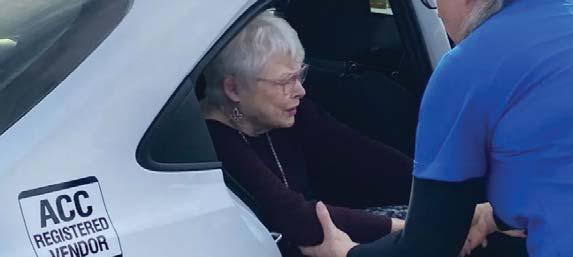
Freedom Companion Driving offers an outstanding pre-booked personal driving service to people in need.
Our local drivers help seniors, people recovering from illness or injury, or those with mobility challenges or disabilities get to their appointments on time, in a stressfree and supported way.
We also help children and teens who need safe travel to school and after-school activities, and we’ll even take your pets to the vet!
Freedom Companion Driving Wellington North provides a wheelchair accessible vehicle.
Freedom Companion Driving offers a personal, caring, reliable (and often cheaper) alternative to taxis.
You can trust our drivers to get you where you’re going, and we also provide extra support at either end of the journey.
Freedom Drivers are ACC Registered Vendors and service providers for the Total Mobility (TM) transport scheme and we accept TM cards, vouchers or ‘taxi chits’





to live with dignity and be valued for the contribution they make to Council operations.”
This outcome is the result of sustained community organising.
In August 2023, the Council agreed in principle to pursue accreditation following an open letter from the community and, later, a packed council chamber of community, faith and union groups to seal the commitment.
Living Wage Accreditation ensures that the Council’s directly employed workers and contracted staff – such as cleaners, security guards, biosecurity workers and restoration workers – are guaranteed the Living Wage each year.
The Living Wage Movement also welcomed the Council’s
in most areas.
In addition to providing transport, we’ll help you find your appointment, carry your bags, and even put your shopping away if you’d like us to.
With a reliable and mindful approach, we care about people and want to promote independent living that doesn’t restrict your needs, or strain friends or family.
The difference from other transportation providers is the companionship you get with each and every journey.
You can be confident that your driver will arrive on time and that you will be personally assisted to your appointment and picked up afterwards.
Our customers become friends and you’ll have the opportunity to build a relationship with a driver who will get to know you and your needs personally.
We are a pre-booked service so give Shekar a ring on 04 333 2828 or 022 542 4179 for a quote.
You can also email Shekar at wgtnnorth@ freedomdrivers.co.nz. PBN




















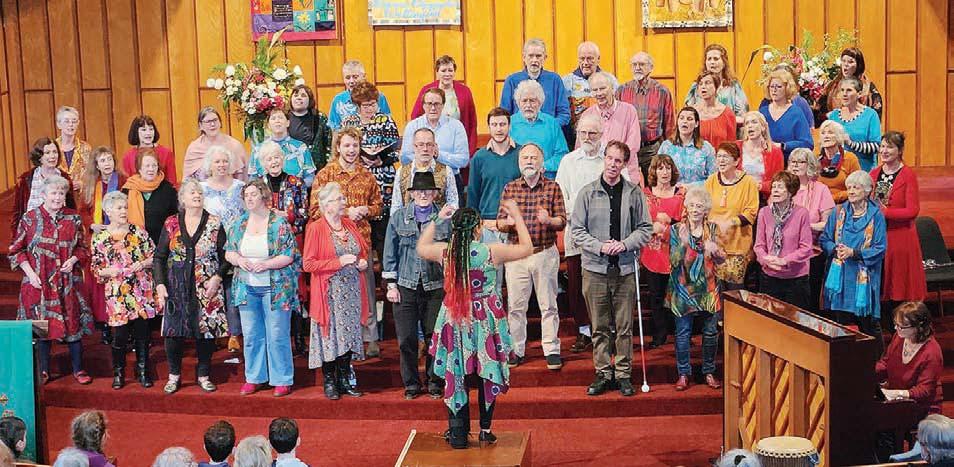
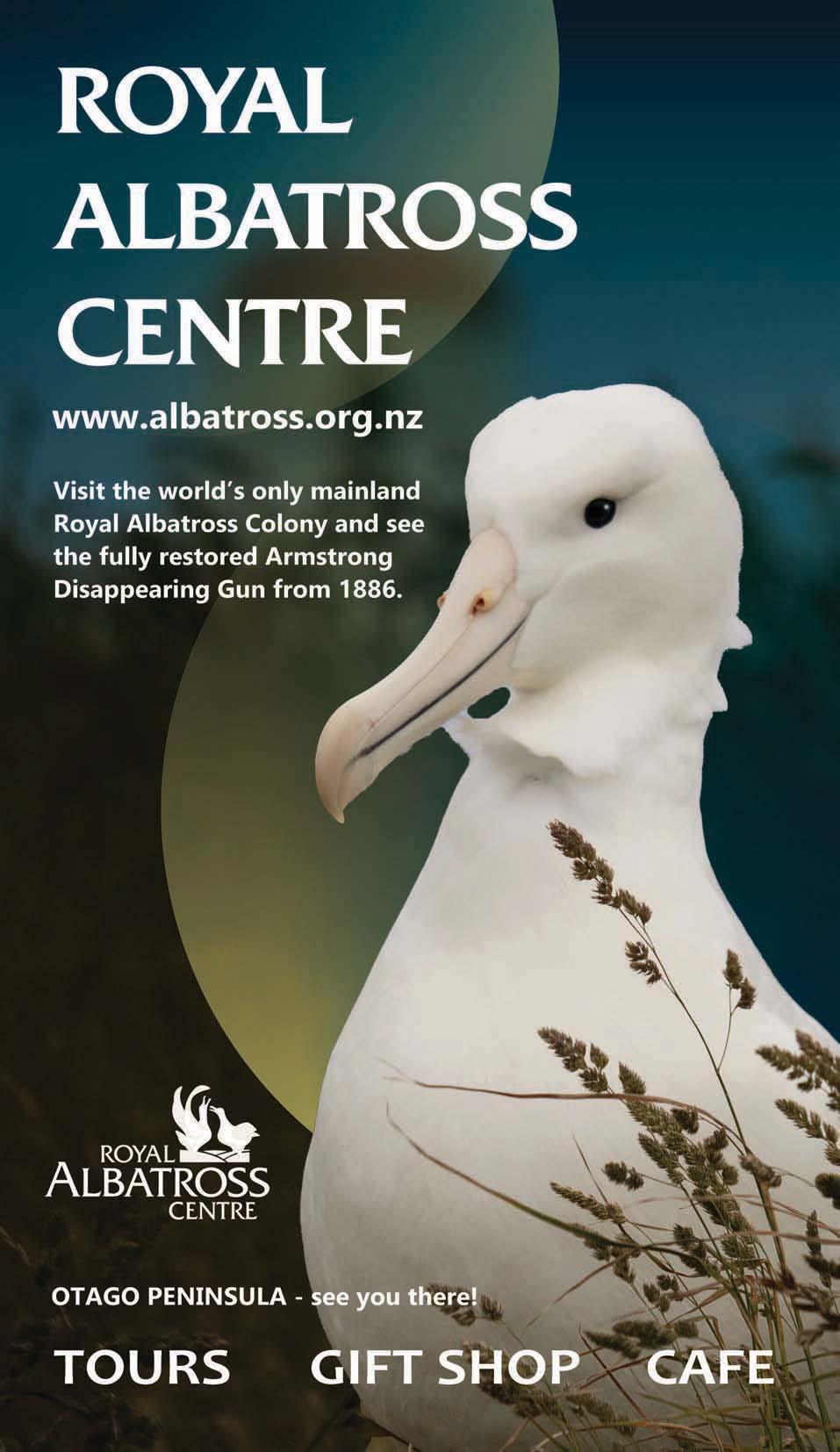

The Wellington Community Choir is celebrating its 20th anniversary with a special concert onthe20 September.
The concert will be held at Wesley Methodist Church, 75 Taranaki St, from 5pm to 6:30pm.
More than 4,500 people have sung with Wellington Community Choir since it started in 2005, including many Karori and Northland residents.
Wellington Community Choir rehearses weekly on Wednesdays from 7.00pm at Te Whaea – National Dance and Drama Centre.
People can just turn up and sing. No audition is required.
The choir’s 20th anniversary concert celebrates friendship and a shared love of singing, summed up by the concert’s theme He waiata tahi, he ng kau tahi; Singing as one, and of one heart.
“It's a love letter to human connection, brought to life through
a vibrant selection of songs that span emotion, culture and tradition,” says the choir’s Director Lala Simpson.
Featuring works by local composers and arrangers,theprogramme is rooted in community and creativity, showcasingtheremarkable talent thriving in the choir’sback yard.
At its heart are two brand newcommissioned works, composed by Lala Simpson and Accompanist Andrea Robinson.
“These original pieces beautifully express what choir and singing mean to our community –connection, resilience andthesoaring joy of unified voices,” Lala says.
“This concert is for anyone who has ever been moved by a melody or found home in harmony.”
Tickets to the 20th anniversary concert are available from Humanitix.com and there will be limited door sales.
For people who have been researching their family history and now wonder what to do next there will be a workshop on Saturday 30 August at the Johnsonville Community Centre Hall.
The workshop has been organised by the four Wellington Region branches of the New Zealand Society of Genealogists to celebrate Family History Month.
The doors open from 9:30am. The talks start from 10am and will run until 4pm.
Various speakers will present on ways to share and preserve family history, with some updates on what’s new in the genealogical world.
Topics covered will include publishing and online sharing of family history, family history software, new research tools and what to with your family history before you are gone.
Representatives from the National Library, Digital NZ and Wellington City Archives and specialist interest groups on English, Scottish, Irish and Australian family history as well as many
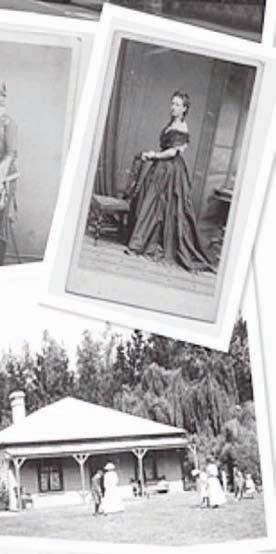
Some of the photos in one family history collection.
Photo: Supplied.
other specialists will be available to answer questions and help participants with their research.

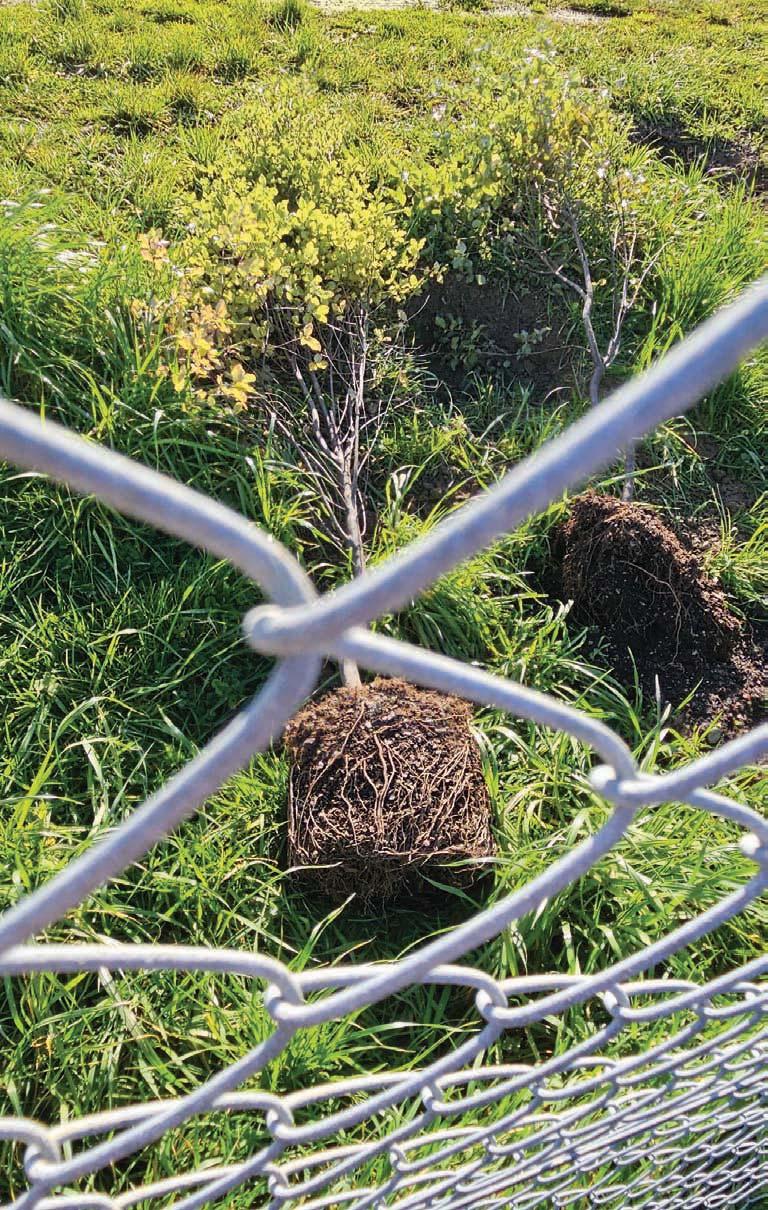
By Frank Neill
Four trees planted by Wellington City Council in Karori’s Ian Galloway Park were recently dug up by Capital BMX Club members.
Six trees were planted by the council at the request of the Karori Residents Association, Wharangi/Onslow-Western Ward Councillor Diane Calvert told the “Independent Herald”.
“The Karori Residents Association had arranged for Council to plant trees to provide shade for the summer,” she said.
The trees were planted on the other side of the fence from the dog walking area at the park.
“The BMX folk decided it would impact on their parking and they dug them up and put them on the ground.”
They admitted digging up the trees, Cr Calvert says.
“Unfortunately it would appear that the BMX Club decided to remove the trees without checking with the Council first.
“I don’t think the BMX Club have handled this very well.
“The BMX Club put the trees back in, but
As Daffodil Day draws closer the team at Cancer Society Greater Wellington wants to express gratitude to the local community.
On Friday 29 August, the Cancer Society will hold its 35th Daffodil Day, raising awareness and funds to support the 1 in 3 New Zealanders who get cancer and their wh nau.
Nearly 1800 volunteers are involved in making the iconic street appeal happen in the Greater Wellington area, says Fundraising and Community Events Team Leader Sandra Davey.
She says she hopes when people see all the pockets of yellow popping up around the city for Daffodil Day collections that people realise “they aren’t alone in their experiences with cancer”.
“Wellingtonians are all in it with them, we see them and want them to have the best support possible!”
Cancer Society Greater Wellington Chief Executive Darryl Carpenter says it is the community’s generous and unwavering support that will help bring to life the Cancer Society’s new vision of ‘working together towards a future free from cancer’.
“It instils a sense of pride in me that our community supports our work to the huge degree they do, and it also instils a sense of honour that our community trusts us to use their donations wisely for the critical work we do.
“We are predominantly funded by our community to deliver the wide range of cancer services and support we offer, the cancer prevention and advocacy programmes we run, and for our significant contribution to research.”

Darryl says the Society has committed to extending and improving its services and support through its Hub network in K piti, Porirua, the Hutt and Newtown.
“With every dollar that is raised, my commitment is to use that wisely, and to honour those who give a little or much, to shift the dial and make a positive contribution and difference in our communities through our services.”
For General Manager Cancer Services
Jenni Drew Daffodil Day 2025 is her fifth in the role.
“I love being able to connect with the community. I never tire of hearing people’s stories. Every time I am just blown away by people’s generosity and people’s ‘why’, people’s reason for giving.”
Her key message for the community is this: “we are here for you”.
“Daffodil Day is a visual reminder that we are in and part of your community. Whether it is researching, advocating for prevention, or supporting people with and after cancer - we are here for anyone who needs us, we are here for you.”



the question is how long have they been out for and have they been damaged.
“I have asked Council officers to look into it and currently they are looking into it,” Cr Calvert says.
After learning the news the “Independent Herald” contacted the Chair of the The Karori Residents Association Andrea Skews and asked her reaction to the trees being dug up.
“It’s taken five years working with Council to get an agreement for some equipment and/or shade options at the dog park,” Ms Skews says.
“It’s very disappointing to see that the BMX Club ripped them out without even checking first.”
Although the BMX Club has put the trees back in the ground they did a “very poor job” of it.
“I’d be very surprised if they survive,” Ms Skews says.
“We are very pleased with what the Council has agreed to and there are some lovely planter boxes going in as well.
“It’s very hot [at the dog walking area of Ian Galloway Park] in the summer and the dogs have nowhere to find shade.”














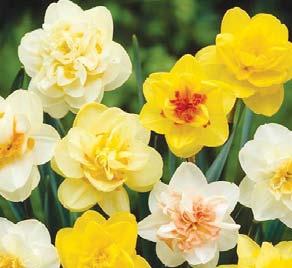









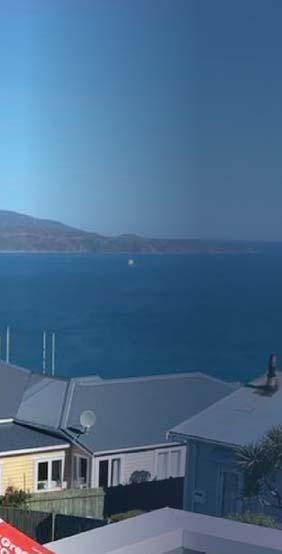



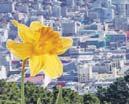








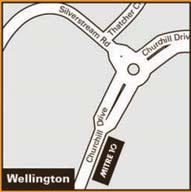












Every day 74 New Zealanders are diagnosed with cancer. For over 35 years New Zealanders have supported the work of the Cancer Society on Daffodil Day and we need your help
again this year. People wanting to support the Cancer Society can do so by donating directly with a street collector, at any ANZ branch, or online at daffodilday.org.nz. Daffodil






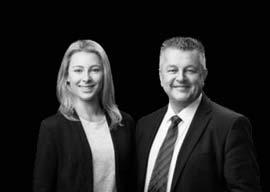














The latest completed section of the Korimako track was officially opened on 23 August.
The opening was celebrated at the water reservoir, at the head of Satara Crescent, taking place on a sunny and windless morning.
The one kilometre track section begins at the water reservoir, rising slightly and then following a contour to join the Northern Walkway at the Tui Lawn on the southern ridge (up from Clark Street) leading to Mt Kaukau.
A group of around 40 heard local MP Greg O’Connor summarise the value of a low gradient track in this area, allowing easy access of many members of the community to the bush.
Greg acknowledged the support of the two Wellington City Councillors present, Diane Calvert and Rebecca Matthews, the financial support from WCC for building the bridge, the two boardwalks and difficult sections of track, and especially acknowledged the contribution from the volunteer Korimako Track Builders for their six months of physical effort.
A video of the Official Opening was made by George Walter, of By George videos, recording the formal parts of the morning, as well as including interviews with several track builders, and views along the track. The video can be seen in YouTube-bygeorgenz.
Following the formal speech, a walk through from the water reservoir to the Tui Lawn and back again was held.
Several of the fitter groups carried on up to Mt Kaukau. This track section passes through mature bush, appreciated by many
present, and offers some spectacular views of the harbour and surrounding hills.
The track section follows the route of Hamish Seaton, who is widely accepted as one of New Zealand’s top track designers.
Track building occurred every Saturday, between 9am to 12am, starting on 25 January 2025 and ending on 19 July 2025. Only two Saturday work parties were cancelled due to bad weather.
On average, 10 volunteers turned out for each work party, and around 30 volunteers worked at some time on the build.
Korimako track has a maximum slope of 6 degrees, or a gradient of one in ten.
This will make the track popular with many walkers and runners, as well as producing a sustainable track surface, and providing an efficient trap-line.
Korimako track follows a low level route, allowing many options for looped walks, based on the higher Skyline track.
On Friday 22 August 165 trees were planted along the track, as a requirement of the environmental consent.
The trees were laid out in position by WCC staff and planted by eight volunteers. Some trees were planted by staff from Track Build Ltd, because access north of the main boardwalk was not then available on the planting day.
Track building has also been subject to a lizard consent, which has required the track route to be surveyed by herpetologists looking for signs of lizards. To date no lizards have been observed along the track route.
Design work on the remaining section of
Bring the Herald to your fingertips - follow us on Facebook for real stories, real people, and the wins that make our town proud. This isn’t just a feed - it’s your front-row pass to community life.

Just by hitting icon and following The Independent Herald, you're in the draw to WIN awesome prizes! Getupdatesthatmatter,supportlocal,andbepartofthe heartbeat of our community. Don’t miss out -




track between Ridvan Grove and Satara Crescent is currently under way with construction expected to begin in the summer of 2025. Notice of this will be given in the Facebook page: Korimako Track Builders. People who want to volunteer, and to be placed on the track building email list, are asked to email grahamweir@xtra.co.nz.
Alternatively, volunteers can simply turn up to a track building session at 9am on a Saturday, with the assembly point given on the Facebook page. Grubbers will be available, if needed.
Regular updates on the project are available on the Korimako Track Builders Facebook page.


Now is the best time to plant trees and shrubs - the garden centres are well stocked. It’s also a good time to revive existing lawns or lay new ones. While the soil is moist the plant roots will have a good chance to establish before the drier months of summer kick in.
If you need help with a planting plan Groundplanz can assist – we will work with you to find a solution that addresses your needs, and is suitable for the environment you live in.
Landscaping that requires earthworks and drainage work is best done in the drier months. Incorporating good drainage, and solving drainage problems, is an important part of our residential landscaping work.


Paving and decks can also provide a good solution for areas that get wet and muddy in winter.
Groundplanz provides professional landscape design and construction services. We can help with garden layout, design of structural features and provide solutions for problem areas. www. groundplanz.co.nz




Water Conservation:
Although conditions can vary, Kiwi summers are becoming hotter and drier, usually leading to water restrictions in Wellington. A rainwater tank allows you to collect and store rainwater for later use, reducing reliance on mains water and helping conserve this valuable resource.
Environmentally Friendly:
Rainwater harvesting reduces demand on local water supplies, crucial in drought-prone regions. It also lessens the energy needed to treat and pump mains water to your property. Plants also prefer rainwater.
Cost Saving: Using rainwater for tasks like garden lower your water bills, particularly during
drought periods when mains water costs may rise.
Emergency Water Supply: With natural disasters, burst pipes, droughts, and other water outages having access to rainwater stored in a tank enables you to
installed with a First Flush unit you can even drink it if needed.
They also have an easy to set tank for bulk storage of drinking water – that is it’s not connected to your downpipe.
For a full range of tank options and setup advice for your situation give the Tank Guy a call – 0508 326 8888 – or visit their website – https://thetankguy.co.nz/ product-category/garden-tanks/
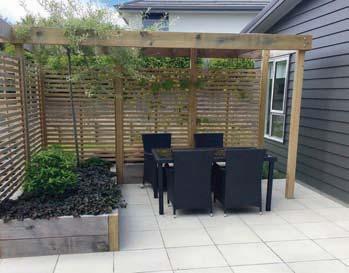

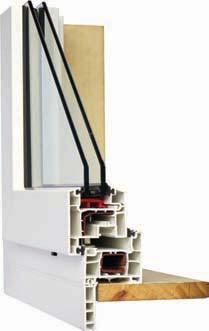







Stronger Together is a new campaign dedicated to a significant increase in young people voting in the upcoming local body elections.
Just 32% of 21 to 25-year-olds voted in Wellington’s 2022 local elections, compared to 71% of those aged 81 to 85 .
This sharp drop shows a serious disconnect. Young people are being left behind in the very decisions that impact them most. “We’re creating a platform for young people to easily access local


government, understand its importance and be part of the change we urgently need,” says campaign lead Ethan Reille. At its heart, Stronger Together is about more than just turnout. It’s about restoring trust in local democracy at a time when communities face a choice between division and collective action. “Now more than ever, our local democracies are at a tipping point,” Ethan says. “We can either stoop to those who incite fear and division to get their way, or we can come together as a
community and take collective action on the issues that matter to us all.”
The campaign has the following goals:
making local elections relevant and accessible.
clear, honest information about local government.
councils have on our everyday lives.
engage in local governance conversations.
representative democracy, including support for M ori wards and lowering the voting age to 16.
Stronger Together will reach young people through digital storytelling, on-the-ground community engagement, and collaborations with groups including Make It 16, Gen-Z Aotearoa, Generation Zero, and Victoria University Students’ Association .
“This is about reclaiming local democracy and making sure young people shape the future of Aotearoa’s cities and towns,” Ethan says. “That means standing up for representation through M ori wards, giving 16- and 17-year-olds a voice in our elections and making sure councils are spaces for all of us. “Local elections shape the places we live, the opportunities we have and the future we’re building. We’re here to make it simple, accessible, and cut through the BS. This is ours to shape.”

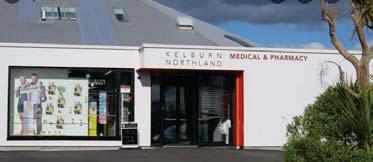
What is cholesterol and why is high cholesterol bad for you? Find out how high cholesterol can affect your heart and how to lower it.
What is cholesterol?
Cholesterol (mat Ū ngako) is a fat-like substance in your blood. It comes from two places: some is made naturally by your liver, and some comes from the food you eat.
Cholesterol isn’t always ‘bad’. Your body needs some cholesterol to work properly. It uses it todevelop cells and hormones, and to process and digest fats. But, if the amount of cholesterol in the blood gets too high, it can cause aheart attackor stroke.
Types of cholesterol
There are two types of cholesterol: Low-density lipoprotein (LDL cholesterol) and high-density lipoprotein cholesterol (HDL cholesterol).
LDL cholesterol is sometimes called ‘bad cholesterol’. When you have too much LDL cholesterol it builds up in the arteries (the blood vessels that carry blood and oxygen around the body).

The build-up of cholesterol causes lumps of hard fat called plaque to form on the artery walls. These can break off, block the artery, and cause heart attacks and strokes.
HDL cholesterol is the ‘good’cholesterol. It works like a cleaner, carrying LDL cholesterol out of the arteries to your liver, where it is broken down and used by the body.
Triglycerides are another type of fat in your blood. When we eat or drink our body turns any energy (calories) that it doesn’t need into triglycerides, which are then stored in fat cells.

than our body needs they stay at a high level, rather than returning to normal.
This is particularly true if our diet includes lots of refined sugar. This includes foods high in added sugar, like sweets, baked goods and chocolate, low fibre carbohydrates, like white bread, and alcohol and fizzy drinks, which include lots of extra sugar.
Like cholesterol, high triglycerides can increase the amount of plaque (hard fat) in the artery walls.

‘lipid test’. Lipid is another word for fat, so this test includes your cholesterol and your triglyceride levels.
When should I get my cholesterol levels checked?
If you haven’t had a cholesterol test before, talk to your doctor or nurse about when you should have one.
If you’re at higher risk of heart attack or stroke because of your or family’s health history, then you may need one at a younger age.



Triglyceride levels normally rise after we’ve eaten, but when we consume more energy
The only way to measure cholesterol is to get a blood test. Sometimes your doctor will call this blood test a ‘lipid profile’or

Cholesterol tests are given routinely as part of a heart health check.
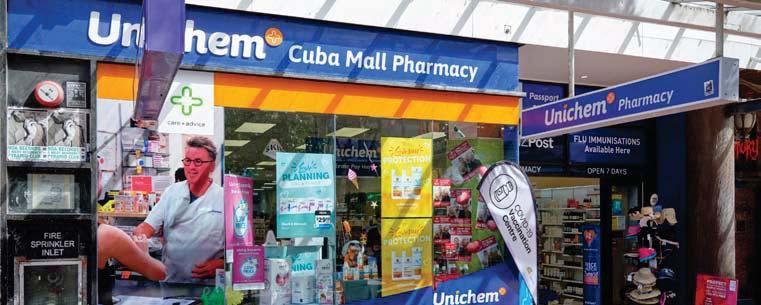



By Felicity Wong
The “most interesting nine-hole golf course in the province” was located in central Johnsonville.
The course was on open rolling country on the south western “outskirts of Johnsonville township” (near Onslow College).
Originating in 1909, the course was laid out in 1912 by Mr Watt of Heretaunga.
It opened with a full membership, mostly of beginners and was soon crowded on Saturdays.
The City Council opened Municipal Links in Berhampore, only a “threepenny section from the centre of the CBD” on a sunny hillside with a similar configuration to those of Johnsonville.
The Berhampore course was “fairly difficult but all the more interesting on that account”.
By 1919, although the Johnsonville Golf Club was depleted of members after World War 1, it was 47 pounds in credit and the course was in good condition.
The Mara Estate, the land it occupied, was however being subdivided for housing within the area originally named Toru Street (now Kipling Street), and around Rua Street (now Sim Street).
The Johnsonville Club had to look for an alternative site and in May 1925 it joined with the Karori Golf Club to ask for some of 130 acres of Town Belt reserve at Lyall Bay.
The newspaper reported that a
large deputation of “two dying golf clubs” met with the City Council’s Reserves Committee.
They advised they represented 300 golfers and asked for 80 acres of the Lyall Bay sand dunes for a new golf course.
The Council was asked to “put them in order” by levelling some of the hummocks for a new course to accommodate 500 golfers.
The Chairman of the New Zealand Golf Council, Mr R C Kirk gave “moral support” to the two clubs “soon to be dispossessed of their not-too-good links.”
There was “no block of land within 20 miles of Wellington suitable for model golf links except the Miramar site” he said.
“The progress of golf all over the world was absolutely phenomenal” and the hundred other courses in New Zealand were “mostly on pasture lands”.
“This was the opportunity for the Council to lay down a very fine course”.
“One of the great virtues of golf was that a man was never too old to learn, and never too old to get pleasure and health out of the game.”
Councillor Martin F Luckie, a member of the Miramar Golf Club who had never played, responded.
“We are to get it ready and lease the reserve to two clubs – is that the idea? There’s not the slightest hope in the world!
“Why you want the whole area. Do you know this is the only land
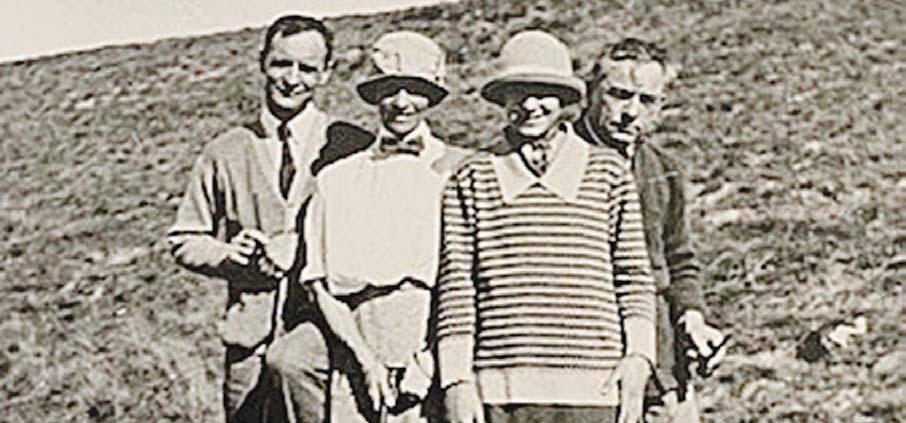
we have left for cricket and football and children’s playgrounds?”
The Reserves Committee Chairman said he “personally had been trying to play golf for six years”.
The clubs offered to pay 300 pounds per year for the lease, and the committee promised to take “the whole matter into consideration.”
Some years later a “Martin Luckie Park” was established in Berhampore.
Meanwhile the Johnsonville course remained in “good order” and trophies were being won.
The newspaper reported “the links are full of interest, and pitfalls abound for the unwary in every direction”.
The club was congratulated for its strong showing,
Subdivision of the land progressed and by late 1927 28 sections had been sold.
The Evening Post prematurely referred to the “late Johnsonville Golf Club”.
In July 1927 however, the Johnsonville Golf Club opened new links in Petone on an island that had been used by the Gear Meat Company’s slaughterhouse and freezing plant.
Over a hundred people attended the opening hosted by Club President, Mr Wallis and Club Captain Mr J M Ellis.
The Chairman of the Hutt River Board, Mr T W Strand, noted that the River Board was only trustee of the property, but was seeking special legislation in order to develop Gear Island into sports grounds for all kinds of games.
It was mentioned that “Gear Island” was not a suitable name, and that suggestions for a new name would be welcome “preferably a M ori one”.
It became Shandon Golf Course, named after Mr Ellis’ hometown.
A postscript, in 1937 the Johnsonville Town Board heard that houses built on the Johnsonville links were struggling to deal with their own drainage.
They were attempting to deal with it by digging shallow trenches but the soil was not suitable for absorbing the moisture.
Today, the Berhampore Club and a nine hole remnant of the Miramar Club near the airport remain.
























The Community Noticeboard is for non-profit organisations. For $15.00 you can publish up to 25 words. No AGMS, sporting notices or special meetings. Community Notices must be pre-paid.
phone (04) 587 1660 or email classifieds@wsn.co.nz
connected to ancestral heritage and deeply embedded in the city’s social and cultural fabric.

Wellington City Libraries have some great events organised to celebrate New Zealand Chinese Language Week, which runs from 31 August to 6 September.



The Eiffel Tower can be 15 cm taller during the summer due to thermal expansion.

We are all different in life, our funerals should reflect this.

“Chinese Wellingtonians: From Sojourners to Settlers” will be presented on Thursday 4 September from 5:30pm to 6:30pm at Te Awe Brandon Street Library.
This fascinating talk explores the transformation of Chinese Wellingtonians’ identity from sojourners to permanent settlers.

Historically, Chinese immigrants in Wellington – like many across New Zealand – maintained a mindset of luò yè guĪg n ( , “fallen leaves return to the roots”), viewing their stay as temporary and their true home as elsewhere.

Over generations, however, this narrative has shifted towards luò dì sh ng g n ( , “take root where you land”), reflecting new forms of belonging, placemaking, and cultural negotiation in Aotearoa.
Drawing on oral histories, community archives, and contemporary perspectives, this talk highlights how local Chinese communities have navigated changing migration policies, intergenerational expectations and bicultural frameworks to forge a distinctive identity as Chinese Wellingtonians – simultaneously
The talk will be presented by Professor Bo Zhiyue.
Porfessor Bo is a leading authority on Chinese elite politics globally and is the Founder and President of the Bo Zhiyue China Institute.
He has taught at universities around the world including Peking University, the University of Chicago, American University, the National University of Singapore and Victoria University of Wellington.
Professor Bo holds a Bachelor of Law and Master of Law in International Politics from Peking University, and a PhD in Political Science from the University of Chicago.
Professor Bo has published more than 400 book chapters and articles on a variety of topics, as well as 16 books and monographs. Beyond his academic work, Professor Bo is an accomplished artist, a health columnist, a pianist and a vocalist.
“Yafeng Chinese Culture Group – Calligraphy and Paper Art” will be held on Sunday 31 August from 1:30pm to 3:30pm at Te Awe Brandon Street Library. Acclaimed artists from Yafeng Chinese Culture Group (finalists in theArts and Culture category










at the Wellington Airport Community Awards)will be visiting Te Awe Library for a demonstration.
“Come along and immerse yourself in paper cutting, beautiful calligraphy and stunning paper quilling,” Wellington City Libraries says.
Each library branch is also offering a poetry walk during this period. There will be posters around the library. Each poster will have traditional poems for people to read in English, Mandarin and Cantonese.
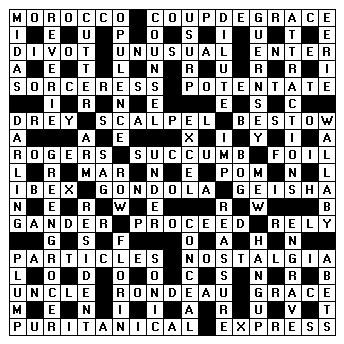


By Hamish Wareham
One more round remains and boy doesn’t it feel like yet another both men’s and women’s Central League season have flown by.
It feels like just yesterday that both preseason competitions had just begun.
However, fast forward to now and this coming weekend is going to be a judgement day of sorts for the Waterside Karori women’s team currently sitting fourth on the women’s Central League ladder one point behind Petone in third.
Wharfies briefly moved up to third on the ladder on 23 August when they trounced bottom of the table Victoria University 6-1 at Boyd Wilson Field.
Renee Bacon scored a hat trick along with Taylor Cooper, Isabella Ismail-Sanders and an own goal on the scoresheet.
Petone took back third spot on Sunday afternoon in the Hawkes Bay, scoring a goal in each half to help them past Taradale 2-0.
The final round of women’s Central League takes place this coming weekend, with Waterside Karori needing to beat Wellington Phoenix Under 18s at Karori Park and rely on bottom of the table Vic Uni surviving relegation by beating or at least drawing with Petone at Memorial Park.
With one round to play the Women’s Central League Table is: Wellington United (51 Points), Wellington Phoenix (43),
Petone (34), Karori (33), Palmerston North Marist (25), Taradale (21), Miramar (12), Palmerston North United (10), Moturoa (9) and Victoria University (8).
In the men’s Central League, the main focus point heading into this weekend’s final round is tenth spot on the ladder with, remarkably, three teams still facing the drop into Central League two.
This past weekend, saw Miramar first of all thrash Waterside Karori 8-1, and Wellington Olympic being crowned Central League champions for the fifth year in a row sealing the title with a 5-0 win over Island Bay.
Western Suburbs sealed themselves National League qualification by beating Upper Hutt 3-0 at Maidstone Park and Napier played their final home game for 2025 and beat Petone 5-1.
Where it matters, though, was at Fraser Park and despite being 2-0 down after 25 minutes, North Wellington scored two second half goals to salvage a point out of a losing situation with Benji Holden and Phoenix Loanee Fletcher Pratt on the scoresheet for Stu Pynes’ side.
This Saturday sees 10th placed North Wellington (11 points) host eighth placed Upper Hutt (13 Points) at Alex Moore Park at 3pm in the game of the round.
Ninth placed Island Bay (12 Points) travel to Endeavour Park to take on Wests.
While it would require a slight miracle for Upper Hutt to go down, still after 17 match
By Frank Neill
Johnsonville boxer Harry Flowerdew has been selected in the Wellington team to compete in the 2025 New Zealand National Boxing Championships.
Harry will be vying for the national title in the 75kg middleweight division at the championships, which will be held at the Te Rauparaha Arena in Porirua from 23 to 27 September.
Of Indian and English descent, Harry started boxing at the Green Gloves Boxing Gymn in Newtown when he was 14 years old. Before that he had tried a variety of sports, not finding anything he really enjoyed until he tried boxing.
Boxing, he says, “just seemed like the perfect mix in a sport for me”.
He began boxing competitively in 2021 and has now completed 22 bouts.
Harry was crowned both the Wellington champion and the Golden Gloves Champion last year. He won two Canterbuury Championships in succession in 2022 and 2023.
One of the highlights of Harry’s career to date, he says, was training out of the same gym as Anthony Joshua in England in 2022, at the same gym where his father used to train.
Harry says he is looking forward to competing at the New Zealand Boxing Championships, adding that he feels like his time has come in a sport that he loves with a passion.
One of the challenges Harry has had to face has been overcoming injuries.
He had to take eight months away from boxing after breaking his hand twice, but was able to continue running and fitness training.
It is, he says “going to take more than a broken hand to stop boxing”.

at the National Championships next month. Photo: Supplied.




North Wellington Football Club (NWFC) is warning that the Government’s proposed Online Casino Gambling Bill, which excludes any requirement for community profit sharing, will strip vital funding from grassroots sport and community groups across New Zealand.
Class 4 gaming grants currently make up 46% of the Johnsonville-based NWFC’s revenue.
The funds support essential costs such as equipment, kits, ground hire and tournament travel.
Without these funds, player fees would need to more than double, rising to around $600 per player or critical investment in gear and programmes would be cut.
“Community gaming funding is the backbone of grassroots sport,” says Fraser Kirby, NWFC’s President.
“Without it organised sport will become unaffordable for many families, and clubs like ours will struggle to survive.”
NWFC, founded in 1972, has 1,082 registered players including 612 under the age of 18, with members ranging from four-year-olds to over-50s.
The club highlights that grants have directly benefited players by providing safe football equipment, properly fitted kits and the chance to compete at tournaments – opportunities that would not exist without community funding.
“The Gambling Act has always recognised that gambling profits must benefit the community,” Fraser says.
“By excluding online casinos from this principle, the Government is abandoning decades of social responsibility.
“If digital gambling takes over, community sport will be left with nothing,” Fraser says.
The club is calling on MPs to ask the Minister and Prime Minister: dropped from the Bill?
principle that gambling should benefit communities?
gambling profits are shared fairly?
NWFC is urging all parties to amend the Bill so that online gambling profits continue to support the communities they impact.


Imperial Park, Unit 81, 41 Bouverie Street, Petone, Lower Hutt.

Please come and see us instore with your items for an on-the-spot appraisal and offer. If you are in any doubt, please bring the items in for us to look over.
Gold Jewellery
All Worn or Broken, Modern or Antique/ Estate Jewellery
Gold and Silver coins and bars
Any type and size.

All Coins and Banknotes



All packaged coins and sets, silver and world coins and banknotes.
Watches


Enter Imperial Park, turn right, go straight on to the end, and you ’ll see us. to suit a ran of d Watches Hours
Mon - Fri: 9:30am - 2:30pm Thursday: 9:30am - 6pm
Open Occasional Saturdays check at www.heritagegold.nz
Antique & Estate Jewellery
NZ’s Most Exquisite Range in Gold and Silver. We have Rings, Chains, Pendants, Brooches, and more!
sets, silver an s. e the items r ba P ars

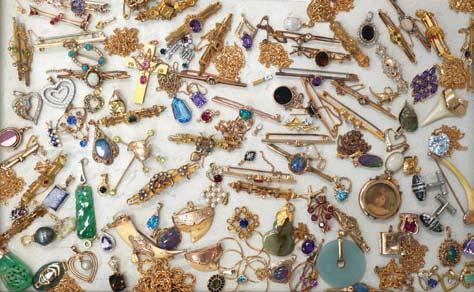
Gold and Silver coins and bars.





Any Condition. Omega, Rolex, Tudor, Longines, and other watches.



or
Investment grade, Verified and Certified, and in a range of sizes to suit a range of budgets.


We Specialise in Buying & Selling all kinds of Jewellery, Bullion, Coins and Banknotes, Silver and Gold items, and Watches. Fully licenced with over 50 years industry experience.

at www.heritagegold.nz